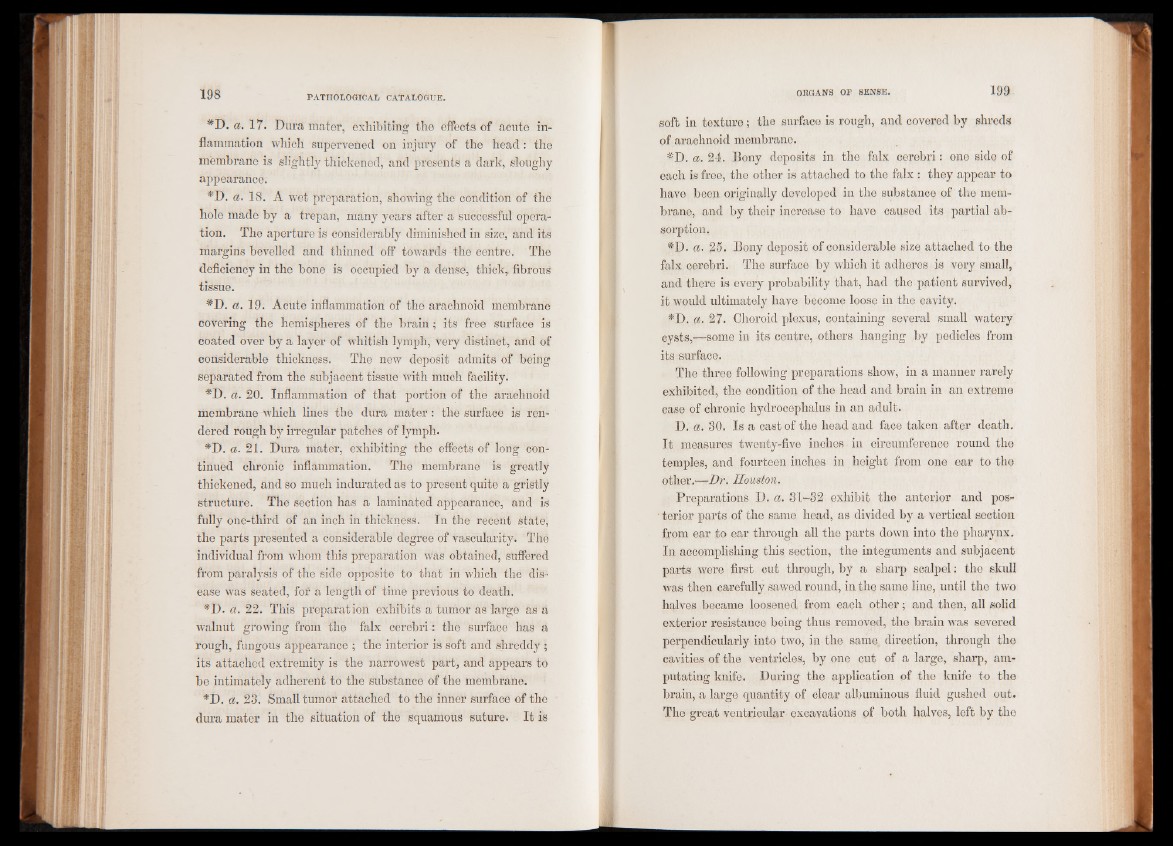
#D. a. 17. Dura mater, exhibiting the effects of acute inflammation
which supervened on injury of tho head : the
membrane is slightly thickened, and presents a dark, sloughy
appearance.
*D. d. 18. A wet preparation, showing the condition of the
hole made by a trepan, many years after a successful operation.
The aperture is considerably diminished in size, and its
margins bevelled and thinned off towards the centre. The
deficiency in the bone is occupied by a dense, thick, fibrous
tissue.
#D. a. 19. Acute inflammation of the arachnoid membrane
covering the hemispheres of the brain ; its free surface is
coated over by a layer of whitish lymph, very distinct, and of
considerable thickness. The new deposit admits of being
separated from the subjacent tissue with much facility.
*D. a. 20. Inflammation of that portion of the araehnoid
membrane which lines the dura mater : the surface is rendered
rough by irregular patches of lymph.
*D. «.21. Dura mater, exhibiting the effects of long continued
chronic inflammation. The membrane is greatly
thickened, and so much indurated as to present quite a gristly
structure. The section has a laminated appearance, and is
fully one-third of an inch in thickness. In the recent state,
the parts presented a considerable degree of vascularity. The
individual from whom this preparation was obtained, suffered
from paralysis of the side opposite to that in which the disease
was seated, for a length of time previous to death.
*D. a. 22. This preparation exhibits a tumor as large as a
walnut growing from the falx cerebri : the surface has a
rough, fungous appearance ; the interior is soft and shreddy ;
its attached extremity is the narrowest part, and appears to
be intimately adherent to the substance of the membrane.
*D. a. 23. Small tumor attached to the inner surface of the
dura mater in the situation of the squamous suture. It is
soft in texture; the surface is rough, and covered by shreds
of arachnoid membrane.
#D. a. 24. Bony deposits in the falx cerebri: one side of
each is free, the other is attached to the falx : they appear to
have been originally developed in the substance of the membrane,
and by their increase to have caused its partial absorption,
*D. a. 25. Bony deposit of considerable size attached to the
falx cerebri. The surface by which it adheres is very small,
and there is every probability that, had the patient survived,
it would ultimately have become loose in the cavity.
*D. a. 27. Choroid plexus, containing several small watery
cysts,—some in its centre, others hanging by pedicles from
its surface.
The three following preparations show, in a manner rarely
exhibited, the condition of the head and brain in an extreme
case of chronic hydrocephalus in an adult.
D. a. 30. Is a cast of the head and face taken after death.
It measures twenty-five inches in circumference round the
temples, and fourteen inches in height from one ear to the
other.—Dr. Houston.
Preparations D. a. 3 L-32 exhibit the anterior and pos-
■ terior parts of the same head, as divided by a vertical section
from ear to ear through all the parts down into the pharynx.
In accomplishing this section, the integuments and subjacent
parts were first cut through, by a sharp scalpel: the skull
was then carefully sawed round, in the same line, until the two
halves became loosened from each other; and then, all solid
exterior resistance being thus removed, the brain was severed
perpendicularly into two, in the same, direction, through the
cavities of the ventricles, by one cut of a large, sharp, amputating
knife. During the application of the knife to the
brain, a large quantity of clear albuminous fluid gushed out.
The great ventricular excavations pf both halves, left by the